Capitol Park is considered one of the most beautiful State Capitol grounds in the nation. Covering 40 acres and spanning 12 city blocks, the park contains species of plant life from nearly every part of the globe and was laid out in typical Victorian style, with long lanes leading between beds of vivid annuals. The park is also home to many monuments and memorials, including the World Peace Rose Garden, California Peace Officers’ Memorial, the Vietnam Veterans Memorial, the Pioneer Camellia Grove, and the Thomas Starr King Memorial.
California American Portuguese Veterans Memorial
Dedicated: June 10, 2017
This memorial honors all California veterans, men and women, of American Portuguese descent. The memorial consists of a granite bench embedded with the emblems of all branches of the Armed Services and surrounded by engraved pavers, listing the names of veterans.
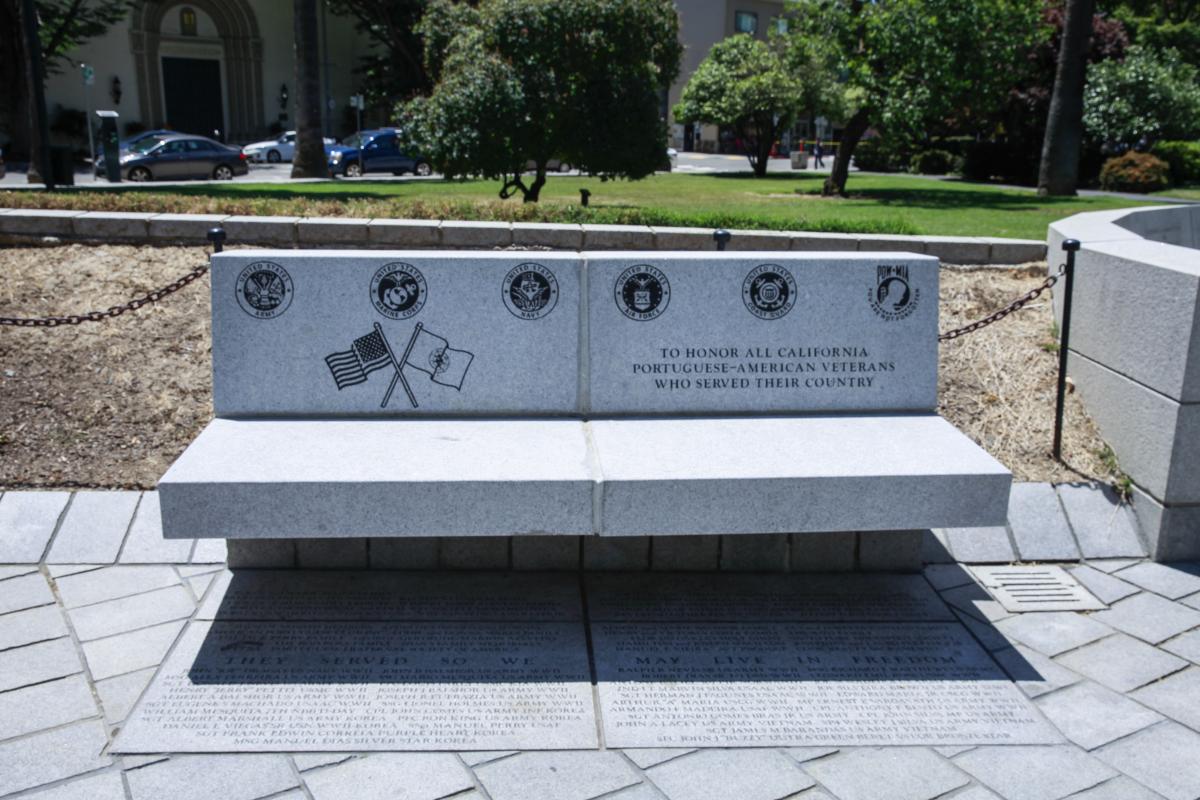
California Civil War Veterans plaque
California Civil War Centennial Commission
Dedicated May 30, 1963
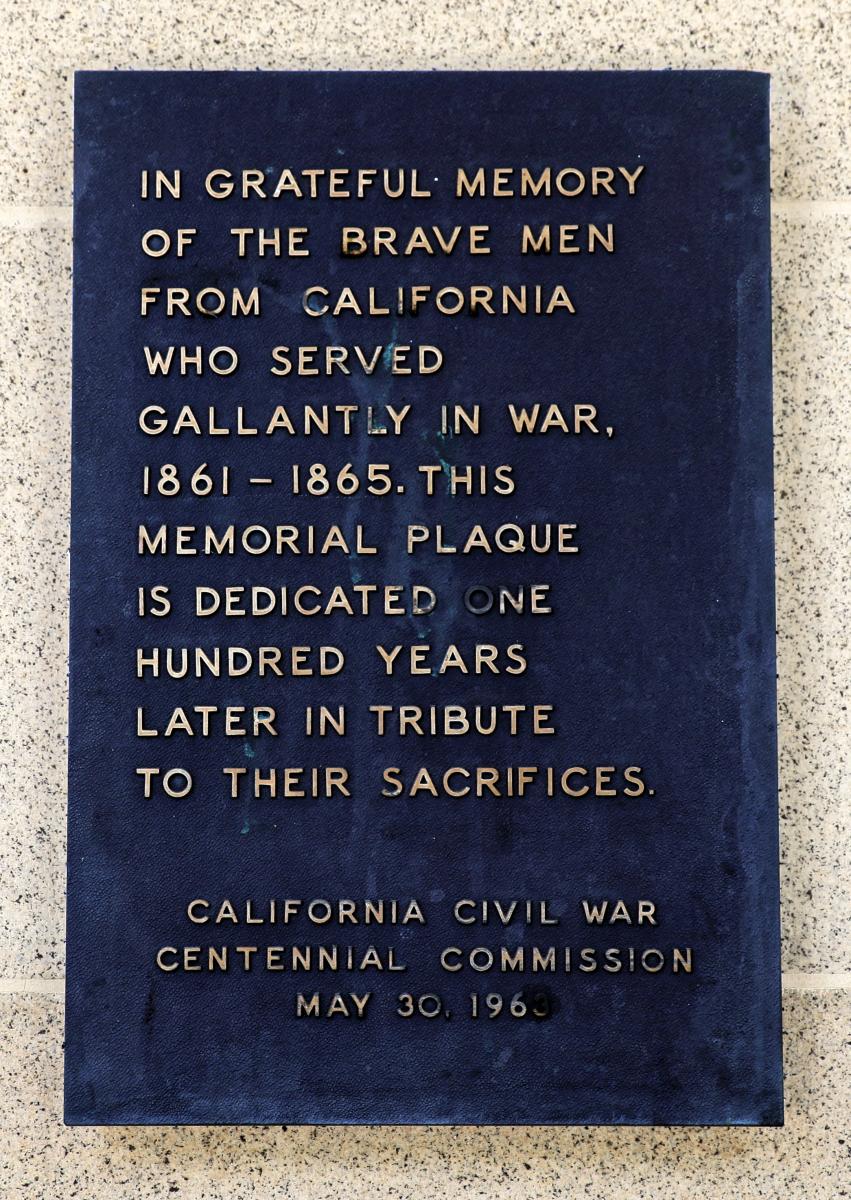
California Commemorative Seals
Dedicated: May 28, 2002
These two six-foot diameter bronze seals recognize California’s history prior to statehood, honoring California Indians and California’s Spanish-Mexican heritage.
California Indian Seal – Artist Robert Freeman, a Luiseno Indian born on the Rincon Indian Reservation in San Diego County, designed this seal. It commemorates the contributions, history, and continuing sovereignty of generations of California Native Americans. An Indian woman, with infant and child, symbolizes the importance of family unity and cultural continuity. A basket, oak tree, dancer holding wands, and a man wearing a flicker quill headdress and clamshell necklace reflect diverse aspects of Indian culture. Two figures journeying by boat represent coastal Indian tribes. Three military jets portray the military experiences that many Indians have in common.
Spanish-American Seal – Artists Donna Billick and Susan Shelton, who was born in Mexico City, designed this seal. It commemorates the contributions and history of Spanish-Mexican California. A Spaniard’s profile and the frontal view of an indigenous person are depicted in the center of the seal; when combined, a third face emerges. Other images reflect the first encounters of the two cultures and chronicle the ensuing transformations. Powerful symbols and icons represent the Spanish, Mexican, and Spanish-Mexican-Californian periods.
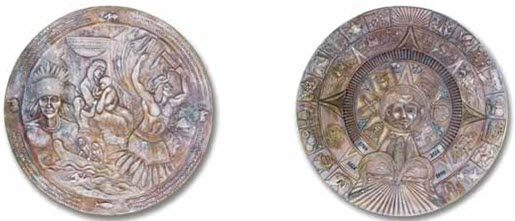
California Firefighters Memorial
Dedicated: April 6, 2002
Dedicated in 2002, this memorial honors firefighters who have lost their lives in the line of duty. The sculpture of four was modeled after real California firefighters. The second sculpture is a firefighter helping a fallen colleague. The Memorial Wall is made of granite, a rock indigenous to California. Listed on the wall are the names of all fallen firefighters since 1850.

California Mexican-American Veterans Memorial “El Soldado”
Dedicated: September 16, 1976
Re-dedicated: October 11, 2017
This memorial is unique among the many memorials dedicated to war veterans both in Capitol Park and throughout the nation. The statue was established and funded by the mothers and wives of California’s Mexican-American soldiers who had fallen during WWII. Creating “La Sociedad de Madres” (Society of Mothers) in 1948, the women hosted fundraisers until they had enough funds to purchase the marble statue from Italy. Originally placed in 1951at what was once Sacramento’s Mexican-American Center, the statue was moved in the 1970s then relocated to its current location in 1990. In 2016, the statue was removed for repairs and cleaning. Shortly thereafter, the California Department of Veterans Affairs and the Department of General Services completed a year-long expansion project of the memorial’s plaza.
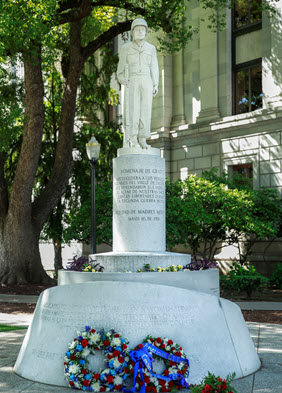
California Peace Officers’ Memorial
Dedicated: May 13, 1988
This memorial was designed by retired Division Chief Vic Riesau and honors the more than 1,300 peace officers who gave their lives in the line of duty. The centerpiece is a 13-foot tall bronze relief sculpture of three figures, representing the evolution of California law enforcement. The figures represent an 1880’s county sheriff, a 1930’s state traffic officer, and a 1980’s city patrolman. The figures look down on a bronze figure of a woman comforting a child sitting on a bench, recognizing the sacrifice of those loved and left behind. Inscribed on the pedestal are the simple, yet meaningful words: “in the line of duty.” A brick planter surrounds the figures, bearing the names of fallen peace officers. Each May, family and friends gather to honor those officers who have fallen in the line of duty the previous year.
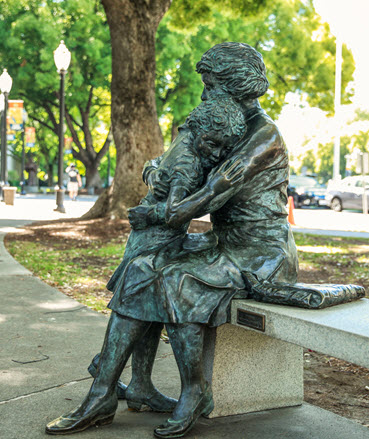
California Registered Historical Landmark # 872
Dedicated: August 10, 1974
Heritage ‘76 Bicentennial Landmark
Dedicated in 1976, commemorating America’s bicentennial year
Rededicated: January 9, 1982
The 1974 landmark plaque was originally placed by the State Department of Parks and Recreation. In 1982, it was rededicated in cooperation with the State Legislature to commemorate the close of California's bicentennial Capitol Restoration Project. Both plaques are embedded in a granite base, which itself is marked with a third plaque, declaring that the slab once sealed the Capitol’s cornerstone time capsule inside the northeast corner of the building, but was relocated in 1982.

California State Seal
Adopted by the Constitutional Convention of 1849, the seal features various symbols of California. The 31 stars represent the number of states that existed upon California’s admission to the United States in 1850. A grizzly bear feeding on grape vines next to a sheaf of grain represents the abundant wildlife and agricultural richness of California. Below the Sierra Nevada Mountains, a minor works near the Sacramento River, busy with commercial traffic. The word Eureka (Greek for “I have found it”) most likely refers to the discovery of gold. Minerva, the Roman goddess of wisdom, overlooks the scene.
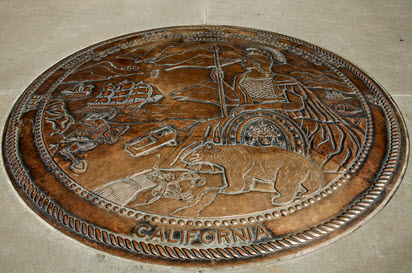
California Veterans Memorial
Dedicated: December 12, 1998
This memorial honors the more than five million Californians who have served in the U.S. Armed Forces since statehood in 1850. An arc of flags representing the various branches of the U.S. Military borders a 30-foot black granite obelisk. Images of war taken from photographs are etched into the granite structure, and range from soldiers wounded in combat to a wife and child welcoming a serviceman home. Narrow fissures slice through each side, symbolizing the devastation of war.
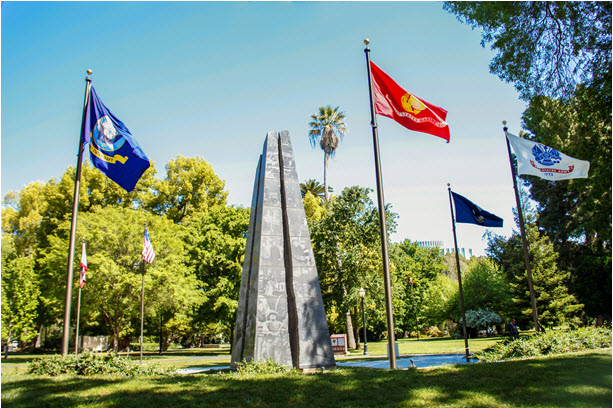
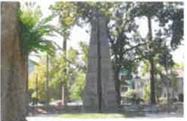

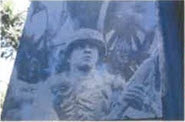
California Vietnam Veterans Memorial
Dedicated: December 10, 1988
This 3,750-square foot memorial, which honors the 350,000 Californians who served during the war, was designed by Vietnam veteran Michael Larson and Thomas Chytrowski, architect, of San Francisco. Fund-raising was led by former Assemblyman B.T. Collins, a Vietnam veteran. The exterior black granite panels are engraved with the names, ages and hometowns of the 5, 822 Californians killed and missing in action in the Vietnam War. The interior panels represent men in combat, daily life and the comradery and friendship of soldiers at war, nurses and corpsmen attending the wounded, and a prisoner of war. In the center is a nineteen-year-old infantryman, representing the average age of those who were lost.
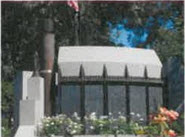



Civil War Memorial Grove
Dedicated: May 1, 1897 by the Ladies of the Grand Army of the Republic of California and Nevada
This was the first monument in Capitol Park. Trees from Civil War battlefields were donated as a memorial to the Union Veterans of the Civil War. Many of the trees have been removed through the years, leaving only three original trees: the Tulip tree, the Turkey oak, and the American elm.
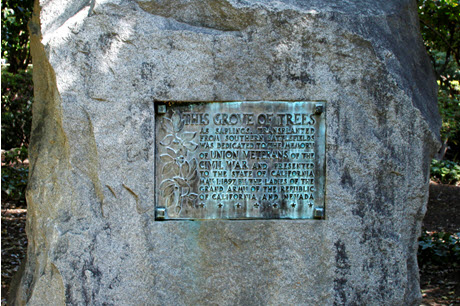
Father Junipero Serra
Dedicated: April 7, 1967 by the Native Daughters of the Golden West, Native Sons of the Golden West, and the People of California
This monument is a tribute to Father Junipero Sera, a priest in the Franciscan order of the Catholic Church. He was charged with leading the development of the California mission system; appointed head of the Spanish missions in 1767, Serra established his first mission in San Diego in 1769. By the time of his death in 1784, Serra had established 9 of the 21 missions: Monterey/Carmel; San Antonio and San Gabriel; San Luis Obispo; San Francisco and San Juan Capistrano; Santa Clara; and San Buenaventura. The eight-foot-tall, bronze statue depicts Serra praying before a map of the State of California. Surrounding the statue are bronze plates, depicting the nine missions. The work was designed by artist Maurice Loriaux, an important figure in the post-World War II Santa Fe art colony. Loriaux founded Santa Fe Studios of Church Art, employing the talents of native New Mexican artists to fashion woodwork, brass, wrought iron, and stained glass, predominantly for Catholic churches. The studios were one of the principal suppliers of ecclesiastical artwork in the United States.

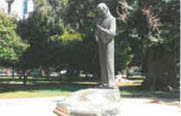

Governor Hiram W. Johnson Memorial Parkway
SCR 77
Filed with the Secretary of State July 1, 1986
Dedicated: October 17, 2008
Senate Concurrent Resolution (SCR) 77 designated Capitol Park’s east-west road as the Governor Hiram W. Johnson Memorial Parkway to commemorate the 75th anniversary of Johnson’s first term. Hiram W. Johnson was a Sacramento native who was elected 23rd governor of California in 1910. His first term is considered one of the most productive periods of state government, with the enactment of numerous laws, including the establishment of the direct primary, the nonpartisan election of judges and school boards, mandatory kindergartens and an eight-hour work day.
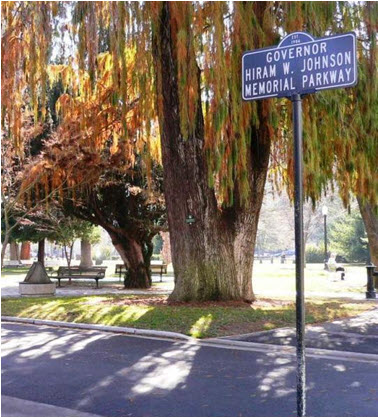
Liberty Bell (Reproduction)
Dedicated by Secretary of Treasury John W. Snyder
As part of the Liberty Bell Savings Bonds drive in 1950, 55 full-size replicas of the Liberty Bell were commissioned by the United State Department of the Treasury and given to states and territories of the United States and the District of Columbia. This bell is one of the bells cast in France by Fonderie Paccard. It was presented to the people of California as an inspirational symbol of freedom.
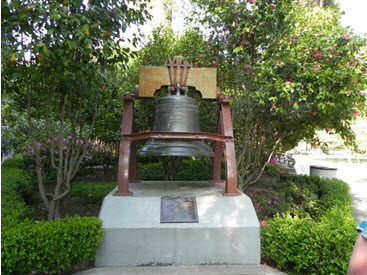
Pioneer Camellia Grove
Sacramento County Parlors of the Native Sons and Daughters of the Golden West
Dedicated: March 8, 1942; expanded in 1946 and 1953
This grove was established as a living memorial to the early builders of California in recognition of their courage, determination and contribution toward progress in the community and the Golden State. It is said that there are more than 800 different varieties of camellias throughout the park, including heirloom varieties no longer commercially available.
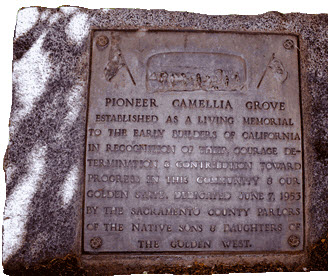
Purple Heart Memorial
Dedicated: August 7, 2010
This memorial is dedicated to the recipients of the nation’s oldest military decoration – the Purple Heart. The original purple heart (an embroidered, heart-shaped badge of purple cloth) was established in 1782 by Commander-in-Chief General George Washington as an award for outstanding military merit. It was awarded to three non-commissioned officers and then not again until 1932, when General Douglas Macarthur revived the award and a medal was struck. In 1932, President Roosevelt issued an Executive Order which provided that the medal would be awarded to members of all US Armed Services who were wounded or killed as a direct result of enemy actions. The memorial is made of red granite with a facsimile of the Purple Heart decoration on the front. Emblems of all the branches of the Armed Services are also included.
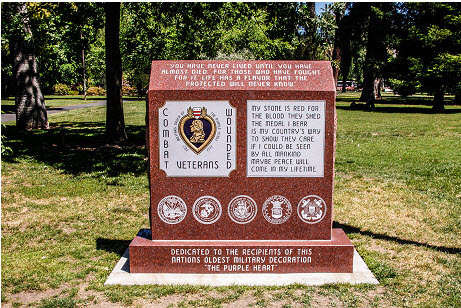
September 11th Memorial
Dedicated: September 11, 2002
This small plaque is dedicated to the memory of those lost on September 11, 2001.

Sisters of Mercy Plaque
Dedicated: December 12, 1986
Sisters of Mercy Memorial
Dedicated: September 2007
This memorial commemorates the 150th anniversary of the 1857 arrival in Sacramento of Sister Mary Baptist Russell, the foundress of the Sisters of Mercy. The Sisters, known as the “walking nuns,” served the untended sick, the destitute, abused women, orphaned children, and the uneducated. They provided California’s first health, education and welfare programs. The Sisters purchased land in the city to build a school; passage of the 1860 “Capitol Bill” resulted in the sale of that property to the state – now the site of the State Capitol building. Sculpted by Sacramento artist Ruth Coelho, the memorial depicts Sister Baptist Russell firmly guiding a worried mother and gravely ill child on a stretcher to the hospital, next to a nurse comforting a young Chinese orphan.
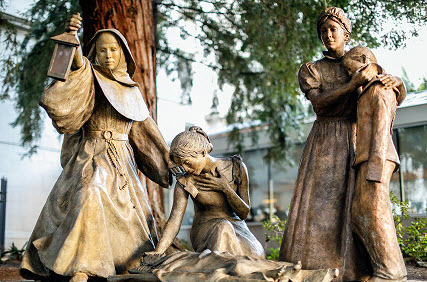
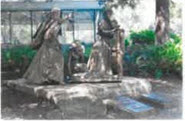
Spanish American War Memorial
Dedicated: June 14, 1949
Erected in 1949, this statue depicts a typical uniformed Spanish American War soldier with his rifle. The soldiers of the 1898-1902 war were known as the “Hikers.”
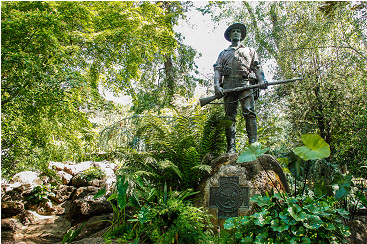
Sundial
1910
Gift of Samuel Howard Gerrish (1834-1912) with a quote from Hawthorne’s The House of Seven Gables. Gerrish was known for his horticultural interests and, beginning in 1883, was a contributing voluntary observer of meteorological data for the State Agricultural Society. His home at 1517 G Street in Sacramento served as a weather observation station from 1906 – 1911.

Supreme Court Justice Stanley Mosk
Dedicated: November 6, 2002
This memorial honors Stanley Mosk, who served as a California Supreme Court Justice and was considered the “guardian of the law and defender of civil rights and civil liberties.” Mosk served for 37 years (1964-2001) and holds the record for being the longest serving justice on that court. He previously served on the Los Angeles Superior Court and was the California Attorney General from 1959 -1964. The statue, sculpted by Lisa Reinertson, shows a young Mosk in his judicial robe, reading a law book. The sculptor said she interviewed friends and family members and used several photos from Mosk’s early days on the Supreme Court to guide her as she created the sculpture. In November 2002, the Library and Courts Building was rededicated the Stanley Mosk Library and Courts Building. Previously that same year, the Los Angeles Superior Court’s central courthouse was renamed the Stanley Mosk Courthouse.

Thomas Starr King Memorial
Dedicated: December 8, 2009
This statue honors Thomas Starr King, the famed Civil War minister who helped to rally California support for the Union. King, a Unitarian preacher, arrived in San Francisco in 1860. His renowned oratory skills and ceaseless advocacy for the Union cause during the height of the Civil War earned him the titles “Apostle of Liberty” and “the orator who saved the nation.” He was also instrumental in fundraising $1.4 million for the U.S. Sanitary Commission – the predecessor to the American Red Cross – and passing an 1864 bill that preserved 20,000 acres of Yosemite Valley for public use and recreation. The sculpture, by Haig Patigan, was originally dedicated in 1931 to stand in National Statuary Hall in the Capitol in Washington, D.C. It was later removed to make way for another statue. In 2009, it was rededicated and now stands proudly near the Civil War Memorial Grove.
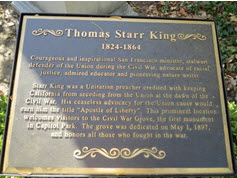
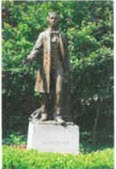
USS California Bell
Dedicated: October 27, 1949 by Governor Earl Warren
The U.S.S. California was launched from Mare Island in 1919 and saw service in Pearl Harbor. The bell was dedicated in 1949.
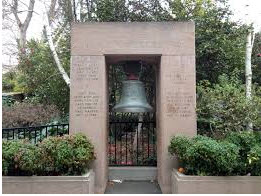
World Peace Rose Garden
Rose garden established: 1953
Peace Garden dedicated: May 16, 2003
The World Peace Rose Garden, created through the International World Peace Rose Garden organization, was designed as a sanctuary of peace, love, and inspiration for people of all nations, cultures, and religions. The garden, dedicated to women, children, and families, is laid out in a Victorian style, with a fountain as its centrepiece. It features more than 650 roses, with more than 153 varieties, colors, and fragrances. Visitors can stroll along the garden's numerous pathways or relax on the benches that line them. Inspirational peace messages written by grade school children are inscribed on plaques throughout the garden. The southeast section serves as a test garden for the All-American Rose Selections. Visitors are afforded the opportunity to see new rose varieties before they are available to the public. The International World Peace Rose Garden is a Sacramento-based, non-profit organization established in 1988. Its mission is to promote peace and harmony in the world through the creation of thoughtfully designed rose gardens that become centers of community action.

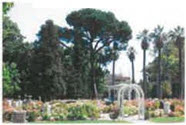
Y-ET-IM THE-LEI-LI! Grinding rock
Circa 1968
This rock and oak tree honor the contributions, past, present and future to the state’s history and culture, by California’s Native Americans.

